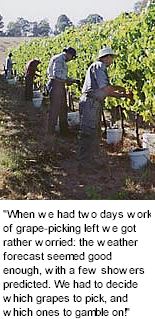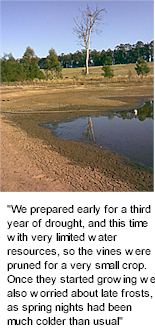


Sarsfield boasts a bridge, a dozen or so houses and a single street light in the middle. There are no shops, no pub and the school has been closed a few years ago. But of course there is always hope that Sarsfield too, will eventually graduate to a traffic light and perhaps a supermarket! The Gippsland area has been inhabited for at least 18,000 years by people of the Gunai or Kurnai tribe, living as hunters and gatherers in the hills and along the rivers and the coast. (learn more: Bataluk Cultural Trail).

The Sarsfield Estate farm, vineyard and winery were developed by Suzanne and Peter who migrated from Switzerland in 1989. They now run a herd of grass-fed beef cattle and produce about 1000 cases of premium red wine annually. They use solar and wind energy and depend entirely on rainwater.
The first European to cross the area was explorer-pasturalist Angus MacMillan, searching for pasture for the drought-stricken livestock of the Monaro high plains in 1840. Two years later, largely ignoring the occupancy right of indigenous people, several cattle stations were established in the region. Within 40 years only 140 of the 1500 or so original inhabitants were still alive. The area was named by Charles Marshall after the famous Irish General Patrick Sarsfield, a distant relative.
Charles Marshall first came to the area with a friend who pioneered a local cattle station. With his whaleboat "Sarsfield" he found the old entrance from the ocean into the Gippsland lakes in 1854, and traveling the Nicholson River he discovered gold. In 1856 Marshall built a store and hotel , the Captain Cook Hotel, to supply travellers to the goldfields of Nicholson and Omeo. His boat “Sarsfield” carried stores and passengers weekly from Port Albert to Sarsfield.

In 1859 a bridge was built across the Nicholson and a town planned. Alfred Howitt, the famous explorer and anthropologist, stayed at the Captain Cook Hotel. He wrote: “We have enlisted the service of that prince of hosts, Charley Marshall, the worthy proprietor of the hotel, to pioneer us over the newly marked township, a few lots of which are to be disposed of at the Government land sale on 23rd instant…” But when only a few lots were sold he remarked: ”I expect Sarsfield will remain another monument of red tape, ignorance and folly.” With the discovery of other, richer goldfields, however, prospectors and miners moved on.
The Captain Cook Hotel was burnt down in the 1860s by Aborigines in retaliation for the shooting of two of their men who were caught shoplifting. A few years later another hotel was built in its place, which was first called Nicholson Hotel, and later Sarsfield Hotel. Sarsfield never grew as a township. Mixed farming, hops, vegetables and dairying eventually became unsustainable and gave way to cattle and sheep grazing. Today the community is growing again, but few people make their income from farming alone.
Today, the environs of Sarsfield Vineyard are all about wildlife observation, vital with cross-country skiing, discovery trails and rich scenic views tailor made for naturalist photographers. Hand-pruned, hand-trained, hand-picked, the Sarsfield Vineyard is more than just grapes! Species diversity is not only vital for easy control of vineyard pests - it is also great fun. Watching animals go about their daily business is easy during vineyard work as our slow, steady moving along the rows lets most animals forget our presence completely.
"Owned by Suzanne Rutschmann, who has a PhD in Chemistry, a Diploma in Horticulture and and a BSc (Wine Science) from Charles Sturt University, and Swiss-born Peter Albrecht, a civil and structural engineer who has also undertaken various courses in agriculture and viticulture. For a part-time occupation, these are exceptionally impressive credentials. Their 2-ha vineyard was planted between 1991 and '98; the first vintage made at the winery was '98, the grapes being sold to others in previous years. High-quality packaging is a plus!" -James Halliday
